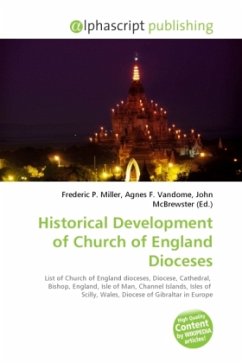
Historical Development of Church of England Dioceses
Versandkostenfrei!
Versandfertig in 6-10 Tagen
62,99 €
inkl. MwSt.

PAYBACK Punkte
31 °P sammeln!
This page traces the history of the dioceses and cathedrals of the Church of England. It is customary in England to name each diocese after the city where its cathedral, is located. Occasionally, when the bishop's seat has been moved from one city to another, the diocese may retain both names, for example Bath and Wells. Cathedrals, like other churches, are dedicated to a particular saint or holy object, or Christ himself, but are commonly referred to by the name of the city where they stand. A cathedral is, simply, the church where the bishop has his chair or "cathedra". The dioceses of the C...
This page traces the history of the dioceses and cathedrals of the Church of England. It is customary in England to name each diocese after the city where its cathedral, is located. Occasionally, when the bishop's seat has been moved from one city to another, the diocese may retain both names, for example Bath and Wells. Cathedrals, like other churches, are dedicated to a particular saint or holy object, or Christ himself, but are commonly referred to by the name of the city where they stand. A cathedral is, simply, the church where the bishop has his chair or "cathedra". The dioceses of the Church of England are administrative territorial units governed by a bishop, of which there are currently 44. These cover all of England, and also the Isle of Man, the Channel Islands, the Isles of Scilly, and a small part of Wales. The Diocese of Gibraltar in Europe is also a part of the Church of England (rather than a separate Anglican church such as the Church in Wales), and covers the whole of mainland Europe, Morocco, Turkey and the territory of the former Soviet Union.












